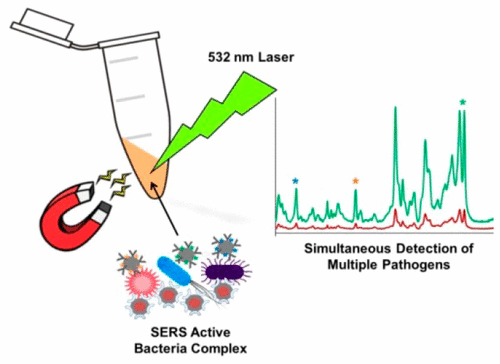当前位置:
X-MOL 学术
›
Anal. Chem.
›
论文详情
Our official English website, www.x-mol.net, welcomes your
feedback! (Note: you will need to create a separate account there.)
SERS Detection of Multiple Antimicrobial-Resistant Pathogens Using Nanosensors
Analytical Chemistry ( IF 6.7 ) Pub Date : 2017-10-20 00:00:00 , DOI: 10.1021/acs.analchem.7b02653
Hayleigh Kearns 1 , Royston Goodacre 2 , Lauren E. Jamieson 1 , Duncan Graham 1 , Karen Faulds 1
Analytical Chemistry ( IF 6.7 ) Pub Date : 2017-10-20 00:00:00 , DOI: 10.1021/acs.analchem.7b02653
Hayleigh Kearns 1 , Royston Goodacre 2 , Lauren E. Jamieson 1 , Duncan Graham 1 , Karen Faulds 1
Affiliation

|
Successful pathogen detection is crucial for public health as the threat of infectious disease is dramatically increasing globally due to bacteria developing resistance to many antimicrobial drugs. The increase in bacterial infections has led to urgent demands for simpler, faster, and more reliable detection methods to be developed allowing the most appropriate therapy to be provided. Surface enhanced Raman scattering (SERS) is an analytical technique which has gained a great deal of interest for biosensing due to its sensitivity, selectivity, and multiplexing capabilities. A new bionanosensor has been developed for the isolation and detection of multiple bacterial pathogens via magnetic separation and SERS. This novel assay format involves using lectin functionalized magnetic nanoparticles for capture and isolation of bacteria from the sample matrix followed by specifically detecting bacterial pathogens using SERS active nanoparticles functionalized with antibodies which are strain specific. Therefore, the sample is captured using a “magnetic plug” and interrogated with a laser allowing simple and fast optical detection. Three bacterial pathogens (Escherichia coli, Salmonella typhimurium, and methicillin-resistant Staphylococcus aureus) were successfully isolated and detected, with the lowest concentration for each of the strains detected at just 101 colony forming units per mL (CFU/mL). In addition to single pathogen detection, a mixture of all three bacterial strains was isolated and identified within the same sample matrix using SERS with the triplex detection also being confirmed using principal component analysis. Herein, we demonstrate that this multiplexed bionanosensor is capable of providing rapid and sensitive discrimination of bacterial pathogens both individually, and within a multiplex system, offering opportunities for future point of care devices and advancements in biomedical applications.
中文翻译:

使用纳米传感器的SERS检测多种抗药性病原体
成功的病原体检测对于公共卫生至关重要,因为由于细菌对许多抗菌药物产生耐药性,全球范围内传染病的威胁正急剧增加。细菌感染的增加导致迫切需要开发出更简单,更快和更可靠的检测方法,以提供最合适的治疗方法。表面增强拉曼散射(SERS)是一种分析技术,由于其灵敏度,选择性和多路复用功能,在生物传感领域引起了广泛关注。已经开发出一种新的生物传感器,用于通过磁分离和SERS分离和检测多种细菌病原体。这种新颖的测定形式包括使用凝集素功能化的磁性纳米颗粒从样品基质中捕获和分离细菌,然后使用经应变特异性抗体功能化的SERS活性纳米颗粒特异性检测细菌病原体。因此,使用“磁性塞子”捕获样品并用激光询问,从而可以简单,快速地进行光学检测。三种细菌性病原体(成功分离并检测到了大肠杆菌,鼠伤寒沙门氏菌和耐甲氧西林金黄色葡萄球菌,每种菌株的最低浓度仅为10 1每毫升菌落形成单位(CFU / mL)。除了单一病原体检测外,还使用SERS在同一样品基质中分离并鉴定了所有三种细菌菌株的混合物,并使用主成分分析确认了三重检测。本文中,我们证明了这种多重生物传感器能够单独和在多重系统内快速,灵敏地识别细菌病原体,为未来的护理设备和生物医学应用的发展提供了机会。
更新日期:2017-10-20
中文翻译:

使用纳米传感器的SERS检测多种抗药性病原体
成功的病原体检测对于公共卫生至关重要,因为由于细菌对许多抗菌药物产生耐药性,全球范围内传染病的威胁正急剧增加。细菌感染的增加导致迫切需要开发出更简单,更快和更可靠的检测方法,以提供最合适的治疗方法。表面增强拉曼散射(SERS)是一种分析技术,由于其灵敏度,选择性和多路复用功能,在生物传感领域引起了广泛关注。已经开发出一种新的生物传感器,用于通过磁分离和SERS分离和检测多种细菌病原体。这种新颖的测定形式包括使用凝集素功能化的磁性纳米颗粒从样品基质中捕获和分离细菌,然后使用经应变特异性抗体功能化的SERS活性纳米颗粒特异性检测细菌病原体。因此,使用“磁性塞子”捕获样品并用激光询问,从而可以简单,快速地进行光学检测。三种细菌性病原体(成功分离并检测到了大肠杆菌,鼠伤寒沙门氏菌和耐甲氧西林金黄色葡萄球菌,每种菌株的最低浓度仅为10 1每毫升菌落形成单位(CFU / mL)。除了单一病原体检测外,还使用SERS在同一样品基质中分离并鉴定了所有三种细菌菌株的混合物,并使用主成分分析确认了三重检测。本文中,我们证明了这种多重生物传感器能够单独和在多重系统内快速,灵敏地识别细菌病原体,为未来的护理设备和生物医学应用的发展提供了机会。































 京公网安备 11010802027423号
京公网安备 11010802027423号